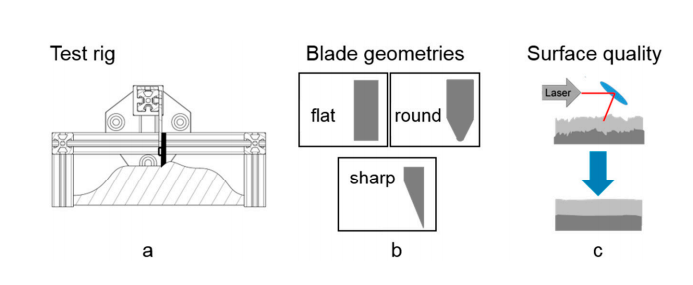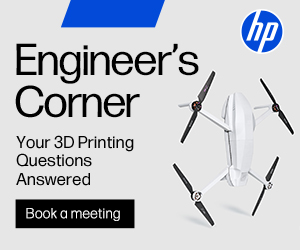Researchers Study Effects of Blade Shape & Grain Size Distribution in SLS Printing
 SLS 3D printing is a fascinating process to watch, as a laser binds material together to build an object, part, or prototype. Selective laser sintering has been in use since the 80’s, one of the main types of 3D printing created by technology pioneers—along with SLA and FDM. Beneficial to users because of its ability to create complex parts that are highly functional, SLS has come a long way as an additive manufacturing process.
SLS 3D printing is a fascinating process to watch, as a laser binds material together to build an object, part, or prototype. Selective laser sintering has been in use since the 80’s, one of the main types of 3D printing created by technology pioneers—along with SLA and FDM. Beneficial to users because of its ability to create complex parts that are highly functional, SLS has come a long way as an additive manufacturing process.
Now, German researchers are expanding on SLS methods as they study the effects of blade shape and grain size distribution, with their findings published in the paper “Influence of Powder Deposition on Powder Bed and Specimen Properties.” Along with savings on the bottom line, the potential for speed in production is one of the main reasons that companies usually begin to explore 3D printing and additive manufacturing. Post processing is a consideration too for most endeavors, with most of us preferring to do as little of it as possible. The researchers considered three different blade shapes in their study, meant for use with PA12 powder and three grain size distributions.
As the researchers explored the rare study of blade geometry, they experimented with flat blades as well as those that were sharp, and those that were round. Parts were tested regarding tensile strength, Young’s modulus, fracture strain. The team also pointed out that component quality is affected by factors such as:
- Humidity and temperature
- Temperature
- Gas flow
- Material selection
- Powder state and properties
- Layer thickness
- Component orientation
- Data set quality
The research team closely examined issues with the state of powders, as they can be vital to the quality of a part—noting that using recycled powders can have a detrimental effect, leading to roughness known as ‘orange peel.’ If the powder is exposed to moisture, it can be comprised. They also stated the following on size:
“It was observed in experiments with different grain sizes, that coarse grains (200 µm) have a better flowability than fine grain powders (63 µm). Due to the higher cohesion between the particles, compared to their gravitational forces, the fine powders were mixed with additives in order to increase their flowability. Furthermore, the normalized packing density was increased to 40.6% compared to 26.6%.”
While evaluating PA12 Original powder for their research, the team used an air sieve separating it into both PA12 Coarse and PA12 Fine. The Sintratec Kit was used for SLS, with the powder heated to 171 ◦C. The blade moves along the powder bed, excess is removed, and then the laser scans the surface. All tensile specimens were fabricated with a flat blade and PA Original.
“Moreover, the influence of the cross-sectional shape of the blades has been investigated using the Sintratec Kit as well as a custom spreading test rig,” stated the researchers. “Therefore, three different geometries were utilized while the original blade has a flat bottom and the other ones were modified regarding their edge geometry.”
Success with the flat blade is attributed to greater compression in the powder bed. The researchers also point out that a rounded or sharp blade will reduce quality, increasing roughness.
“The influence of powder composition and blade geometry on average surface roughness measured by LSM is identical to that of the arithmetic roughness,” stated the researchers. “At approx. 170 µm, powder beds of fine and coarse particles have lower values than the original powder at 180 µm. With regard to the flat blade, a low roughness of the powder bed of approx. 162 µm was achieved compared to the round and sharp blade shape of approx. 180 µm.
“A significant difference between the application direction of the powder and perpendicular to it could not be observed. Compared to the measuring method with the LSM, the roughness values obtained from XMT data are considerably different (Ra ≈ +3 µm and Rz ≈ −20 µm) (Figure 11a–d), which can be attributed not only to the method but also to the smaller sample size which results in lower values along the section of measurements for the average surface roughness.”

Scanning electron microscope (SEM) images of PA 12 Original powder at 200-, 500-, and 2000-fold magnification.
Little difference was found when comparing the fine and coarse powder, and the most noticeable influence on mechanical properties of specimens was build and powder deposition direction.
“Further geometries, their limits and their influence on powder bed compaction have to be explored,” concluded the researchers. “Along with that, appropriate flowabilty characterization techniques can be developed in order to predict the spreadability in a powder bed fusion system. Shear testing might be a suitable method since there are already established devices which provide a good reproducibility.
“When the real shear stress between blade and powder bed is known, adapted configurations and procedures might lead to better results for comparing different powders. Furthermore, low-cost SLS systems are becoming more and more popular for personal use. Besides research on industrial machines the focus needs also to be put on feasible improvements in this sector in order to improve these processes for private purposes and thus, making them more accessible.”
What do you think of this news? Let us know your thoughts! Join the discussion of this and other 3D printing topics at 3DPrintBoard.com.
[Source / Images: ‘Influence of Powder Deposition on Powder Bed and Specimen Properties‘]Subscribe to Our Email Newsletter
Stay up-to-date on all the latest news from the 3D printing industry and receive information and offers from third party vendors.
Print Services
Upload your 3D Models and get them printed quickly and efficiently.
You May Also Like
3DPOD 252: What’s Really Happening in Bioprinting, with Mark Skylar-Scott, Stanford University
Mark Skylar-Scott is an experienced bioprinting researcher now working at one of the foremost bioprinting labs in the world at Stanford University. We talk about inexpensive desktop bioprinters and their...
Printing Money Episode 28: Recent M&A and More with Joris Peels, 3DPrint.com
Welcome to Episode 28 of Printing Money. For this one Danny is joined by our own, Joris Peels (Executive Editor, 3DPrint.com). This crossover-pod is indeed quite meta-level but it’s not...
3DPOD 251: 3D Printing for Football Helmets with Kodiak Brush, LIGHT Helmets
Kodiak Brush grew up playing football before working on crash testing. Sometimes someone’s career can seem like it is inexorably building up to one goal. And with Kodiak now making...
3DPOD 250: Dieter Schwarze, Nikon SLM Solutions
Dieter Schwarze is a true 3D printing icon. Here we get the twisting, arduous tale of Dieter’s journey into additive. Starting with inkjet, SLA and lots of other technologies, Dieter´s...






























